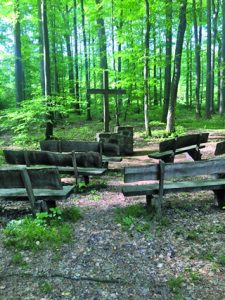Fifty ways to leave your body
Death. It’s a tough subject. But once a year we try to lighten the darkness through Halloween antics. So in the spirit of the season, while skulls and skeletons and tombstones are popping up on lawns and storefronts, let’s take a closer look at what to do once we are done.
Embalmed bodies buried six feet underground in concrete vaults with expensive coffins is a dying tradition. Concerns about the environment, the costs, the space have taken a toll on this practice. In fact, the National Funeral Directors Association (NFDA), predicts by 2035 the national cremation rate will reach nearly 80 percent (or 2.80 million cremations per year). The NFDA also predicts Colorado, along with 11 other states will reach this rate by 2030. But traditional flame cremation is far from eco-friendly. Yes, it saves space, but it’s an energy-intensive procedure reliant on natural gas, a non-renewable fossil fuel, that when used, releases greenhouse gases that trap heat in our atmosphere and cause global warming.
But fear not. The funeral industry (or parts of it) has heard the call for all-natural, organic and sustainable solutions and has responded appropriately. A return-to-earth movement is underfoot in which all roads lead to some form of manageable piles of dust. As Joni Mitchell famously wrote in her song “Woodstock”: We’ve got to get ourselves back to the garden.” And we are. Let’s break it down.

Photo by Sue Arnott – A type of memory forest in Germany where urns are buried at the base of trees.
Human Decomposition
In September Colorado lawmakers passed a bi-partisan bill allowing what mortuary scientists call natural organic reduction of human remains, or in lay terms, body composting. It works like a garden compost pile. Basically, our remains are placed in an insulated box along with a waterproof lining, wood chips and straw. Compost needs oxygen, so the remains are stirred occasionally, and in six months we (save for our teeth and artificial medical devices) become soil. Family members can keep the soil. State law says it is okay to spread this compost in the yard, but it forbids the sale and use of it for fertilizing a garden. How to enforce that is anyone’s guess, so if you know of a family who has chosen this option for a deceased member and they like growing and sharing tomatoes…ask questions.
Washington was the first state to allow human composting. Colorado, the second. Oregon follows come July 2022. Note: for those considering independently burying your environmentally conscious and frugal loved one…don’t. Only licensed funeral homes and crematories are allowed to compost human bodies.
For more local information on this, contact a funeral home or The Natural Funeral in Lafayette, CO, where efforts to legalize this procedure began. https://www.thenaturalfuneral.com/
Burial Pods
Along these same lines, an Italian project called Capsula Mundi is working on legalizing a method in which (formaldehyde-free) bodies are curled, fetal-position, into an eco-friendly large egg-shaped pod made of special biodegradable plastic. A tree seed is enclosed with the body. It’s still in the idea stage. The concept shares similarities with body composting, but…well, they have a website with, um, interesting visuals.
Alkaline hydrolysis, aka Resomation, aka Water Cremation.
Back to cremation. Gentler, quieter than fire and more environmentally sustainable, water cremation uses water (95%) and a small amount of hydroxide or sodium hydroxide to reduce our bodies to a state of liquid and bone. The process takes anywhere from three to twelve hours. The non-toxic liquid byproduct, a solution comprised of amino acids, peptides, and sugars, can enter sewage systems (much like other materials used during the more toxic embalming process). Bone fragments are reduced to a type of ash that families can keep. Water cremation uses 90% less energy than fire. Its low-carbon-footprint makes this a more attractive option for the environmentally-minded (which should mean all of us). To date, twenty states have legalized water cremation. Colorado is one of those. (Note: the small amount of sodium hydroxide used is not to be confused with the harsher, macabre method of immersing a body in hydrofluoric acid–see Walter White in “Breaking Bad”). That’s a whole other story.
For more information on water cremation and where it is available, again contact a funeral home or email [email protected].
So what to do with what remains.
The possibilities seem endless.
Memory Forests are growing in popularity. There’s something about a tree and a peaceful wooded area that resonates with the human soil, er… I mean soul. Colorado has a memory forest in Boulder; Steamboat Springs has one planned. Ashes are buried in a special biodegradable urn and a tree is planted on top of it. Go to https://www.thelivingurn.com for more information.
Art lovers can have their ashes compressed into a vinyl disc or mixed into paint and used in a painting. Prices for these items vary. Google it. Love the holidays? Create an ornament with ash, or even better, pressurize that dust and make a memorial diamond for your surviving mate. Like a big bang? Contact a pyrotechnic company and be part of a fireworks display. Or if that’s not high enough, consider launching your ashes into outer space, but forget about the environmentally friendly part. And finally, you don’t have to be a sailor for a burial at sea. Eternal Reefs, a non-profit based in Sarasota, FL, designs reefs made of environmentally-safe cast concrete. For a price, they will place your “cremains” on the ocean floor “as a permanent memorial of a life well-lived.” See https://www.eternalreefs.com/.
Please be aware: In Colorado, under NO circumstances are ashes to be laid, scattered or, deposited in any way, shape or form near any water resource. Be good. In life and death.
Stand-alone categories
Space here doesn’t permit an exhaustive list, but it’s worth mentioning if none of the above interests you, perhaps cryonics appeals. The brain is frozen either with or without the body attached in hopes that future medical technologies may provide a path to resurrection. To date no one has yet thawed to tell us how this turns out.
Whatever the case, here’s to peaceful passings, gentle break downs and finding life after this one.
- January, 21 2021

Life saving organ donation radically ...
Kevin Griffith’s life was saved by a gift from a stranger. After years of weekly...
- September, 06 2019

The Surveyor does…A day with th...
If you’ve followed the news in the last few years you’ve probably heard and read...
- April, 17 2015

Planning commission approves variance...
By Rudy Hemmann The Surveyor The planning commission held a brief meeting Thursday, April 9,...
- June, 29 2017

Be a part of the Larimer County Fair
By Edie McSherry Extension Educator, Larimer County Exhibiting your talents at the Larimer County Fair...
- November, 27 2019

Proposed 2020 budget to be approved b...
By Rudy Hemmann The Surveyor This report is a follow-up to the Berthoud Board of...
- December, 02 2021

Town Board hears development code upd...
At the regular meeting of the Berthoud Board of Trustees on Nov. 23, the board...

POLICEBLOTTER
Community News
Northern Water sets C-BT quota at 70% for 2024
Community News

Emotions run high during Revere Property hearing
Community News
Snowpack at 119% above normal
Community News

Karspeck to serve third term as Berthoud mayor
Community News

OPINION – No bitchin’ allowed
Community News
Roy Tripi to become principal of BHS on July 1
Community News
COMMUNITY CALENDAR:
Community Calendar – add an event
Homestead Fine Art Gallery First Fridays OPEN HOUSE
03 May 4:00 PM - 7:00 PM
Homestead Fine Art Gallery First Fridays OPEN HOUSE
07 Jun 4:00 PM - 7:00 PM
Homestead Fine Art Gallery First Fridays OPEN HOUSE
05 Jul 4:00 PM - 7:00 PM
Homestead Fine Art Gallery First Fridays OPEN HOUSE
02 Aug 4:00 PM - 7:00 PM
Homestead Fine Art Gallery First Fridays OPEN HOUSE
06 Sep 4:00 PM - 7:00 PM
Homestead Fine Art Gallery First Fridays OPEN HOUSE
04 Oct 4:00 PM - 7:00 PM

